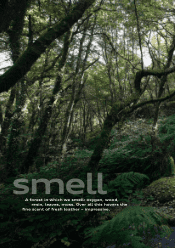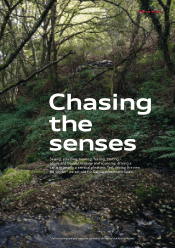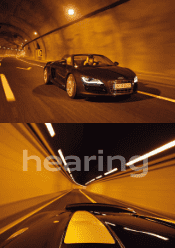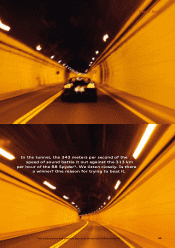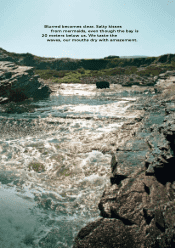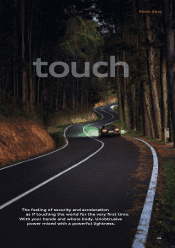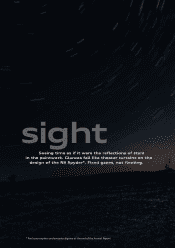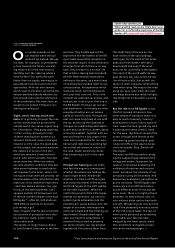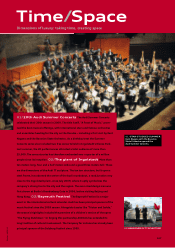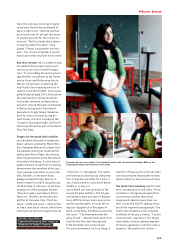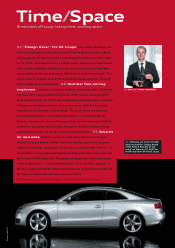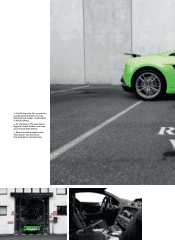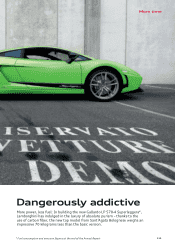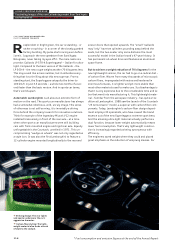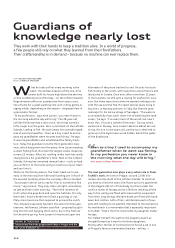Audi 2009 Annual Report Download - page 109
Download and view the complete annual report
Please find page 109 of the 2009 Audi annual report below. You can navigate through the pages in the report by either clicking on the pages listed below, or by using the keyword search tool below to find specific information within the annual report.
106
and now. They huddle against the
experience like the leather of the R8
sport seats around the receptors in
the shoulder region. A new dimension
emerges from which there is no way
back. Only a return to a normal life
that is duller. Having been bombard-
ed with fresh sensual impressions,
nothing is the same, as a new climax
of intensity has branded itself on our
consciousness. An experience which
leaves its mark, like holding hands
with your first true love. This is the
moment we captured our senses, and
now you are close to your first trip in
the R8 Spyder. Driving a car is a sen-
sual experience – in virtually no other
everyday situation are our senses
called on more forcibly: Through the
seat our tense body feels at one with
the car, perceiving the slightest of
changes, its roadholding and lateral
acceleration as the four wheels dance
across the asphalt. Together with our
eyes and muscles a tiny organ in the
inner ear is responsible for our equi-
librium and right now is working full
out so that we remain in control of
the road. Depth sensitivity checks
that everything is still in the right
place.
Through our hearing we can check
how fast the engine is running and
whether the wheels are holding the
road in tight bends. And decide
whether it is time to shift up a gear
with a tiny movement of the second
and third fingers at the shift paddle
on the steering wheel. When the
comforting sound of the V10 engine
reaches our eardrums, our nervous
system injects adrenaline into the
bloodstream, goose bumps cover the
length of our arms, whereupon we
reach out a hand and start feeling our
way forward. Despite wanting to
open our mouth in amazement, it
remains firmly closed to preserve
our sense of taste; our lips pressed
together as if to protect them from
the slight tang of the sea air. Our
nose monitors the surroundings,
testing air for the smell of hot brake
pads and fresh leather. We take a
deep breath and even if the wind
does not hit us directly in the Spyder,
the scent of the world wafts its way
past the tiny hair cells to the 30 mil-
lion olfactory cells. Just as well our
sense of smell is sharper when sitting
than when lying. We keep to the road
using our eyes, even when the road
markings become blurred at twilight,
like footprints in the sand in a rising
tide.
But the ride in an R8 Spyder is just
the first sensual dimension. Few
other means of transport make it so
easy to reach classically “sensory”
destinations in such a short space of
time. Leave the loud, garish city with
its permanent sense overkill, head
for the even, rhythmical sound of the
ocean, through dark forests to the
shimmering green heartland, past
rusty red cliffs on the way to decep-
tive silent peaks. Stop. Switch off
the engine.
The open-roof R8 succeeds in bridg-
ing the supposed gap between tech-
nology and nature. Supposed, be-
cause it is not about evaluating the
antithesis of machine and environ-
ment, but about the intensity of our
perception using all the senses. And
beyond any evaluation, perception re-
quires contrasts. The R8 Spyder and
nature are not on different scales,
but at different ends of one and the
same scale. There is no light without
darkness, no heat without cold, no
sour without bitter and no hard with-
out soft. Whispering can only become
loud if the pleasantly sonorous sound
of the V10 engine fades. The lack of
wind is only perceived as intensively
warm after your face has been
whipped by the fresh sea air, when
the convertible roof quietly closes
over driver and passenger.
ur senses precede us like
our shadow when the sun
shines from behind. We use
our eyes, for example, to permanent-
ly look towards the future, calculat-
ing what to do in the next second.
Carefully turn the steering wheel a
little further? Our eardrums work
faster than our pupils, warning us to
pay attention as the sound of a horn
approaches. With our skin sensors,
which react to vibration, we sense the
hairpin bend and decide whether our
foot should overcome the resistance
of the accelerator. But how close can
we get to our senses if they are con-
stantly preceding us?
Sight, smell, hearing, touch and
taste. It is primarily through the clas-
sic five senses that we perceive the
outside world. Our sense organs long
for information. They grasp anything
in their vicinity, drawing it in like
children drawing their parents to a
carousel. Rods and cones in the eyes,
receptors in the nose, the taste buds
on the tongue, the sensitive eardrum,
the network of nerves in the skin
which are sensitive to warmth and
touch, with which we taste, feel and
sense ourselves. When our senses
perceive weather conditions they use
data-nerve highways to send electri-
cal impulses to the brain, where, fol-
lowing an initial selection process, we
become aware of the information. We
make use of our wealth of experience
– and then make a decision. Our grip
firmly on the steering wheel: Can I
squeeze another 20 horsepower out
of the ten-cylinder engine in the Audi
R8 Spyder* – after all, 525 stallions
(386 kW) are waiting in the stalls,
just raring to go?
Stop. Imagine that for just a moment
your powers of perception were dou-
bly intensive. Taste, smell, noise,
colors and touch.
The senses no longer have a chance
to look forward, they exist in the here
COPY/SVEN SCHULTE-RUMMEL
PHOTOS/SORIN MORAR
O
SENSE AND SENSIBILITY
When winding roads send a tingle down your
spine. For a multimedia experience of the R8
Spyder visit: www.audi.com/ar2009/senses
* Fuel consumption and emission figures at the end of the Annual Report


